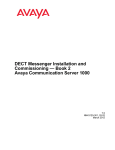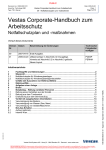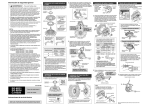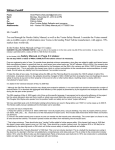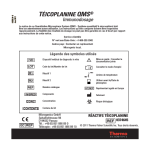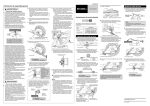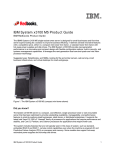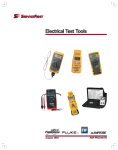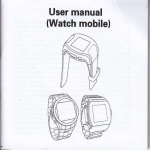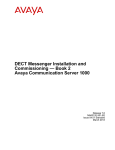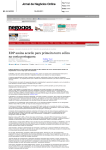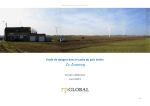Download email from Bob Anders regarding Vestas Letter submitted by Liz Argo
Transcript
William Cundiff From: Sent: To: Subject: Attachments: Robert Anders [[email protected]] Wednesday, January 26, 2011 5:31 AM [email protected] Fwd: Unsigned Letter on Vestas Letterhead Submitted by Ms. Argo and Mr. Jane Vestas Letter submitted by Liz Argo.pdf; ATT00007.htm; vestasv90-100_safetymanual.pdf; ATT00010.htm Begin forwarded message: From: Eric Bibler <[email protected]> Date: January 26, 2011 12:16:06 AM EST To: Kristy Senatori <[email protected]>, Martha Hevenor <[email protected]>, Page Czepiga <[email protected]>, Paul Niedzwiecki <[email protected]>, Ryan Christenberry <[email protected]>, Sarah Korjeff <[email protected]>, Sharon Rooney <[email protected]> Subject: Unsigned Letter on Vestas Letterhead Submitted by Ms. Argo Return-Path: <[email protected]> Received: from mtain-dk07.r1000.mx.aol.com (mtain-dk07.r1000.mx.aol.com [172.29.180.11]) by air-ma08.mail.aol.com (v129.4) with ESMTP id MAILINMA084-b5334d3fae543e4; Wed, 26 Jan 2011 00:17:08 -0500 Received: from mail-vw0-f51.google.com (mail-vw0-f51.google.com [209.85.212.51]) by mtain-dk07.r1000.mx.aol.com (Internet Inbound) with ESMTP id 66367380000FF for <[email protected]>; Wed, 26 Jan 2011 00:16:59 -0500 (EST) Received: by vws20 with SMTP id 20so264696vws.38 for <[email protected]>; Tue, 25 Jan 2011 21:16:59 -0800 (PST) Received: by 10.220.182.7 with SMTP id ca7mr1474168vcb.163.1296019015793; Tue, 25 Jan 2011 21:16:55 -0800 (PST) Received: by 10.220.188.137 with SMTP id da9cs137567vcb; Tue, 25 Jan 2011 21:16:32 -0800 (PST) Received: by 10.236.105.180 with SMTP id k40mr1486130yhg.93.1296018987363; Tue, 25 Jan 2011 21:16:27 -0800 (PST) Received: from mail-yx0-f173.google.com (mail-yx0-f173.google.com [209.85.213.173]) by mx.google.com with ESMTPS id l9si3227846yhl.10.2011.01.25.21.16.24 (version=TLSv1/SSLv3 cipher=RC4-MD5); Tue, 25 Jan 2011 21:16:25 -0800 (PST) Received: by yxl31 with SMTP id 31so2302792yxl.4 for <multiple recipients>; Tue, 25 Jan 2011 21:16:24 -0800 (PST) Received: by 10.236.103.175 with SMTP id f35mr1426630yhg.27.1296018977558; Tue, 25 Jan 2011 21:16:17 -0800 (PST) Received: by 10.236.105.244 with HTTP; Tue, 25 Jan 2011 21:16:06 -0800 (PST) X-Forwarded-To: [email protected] X-Forwarded-For: [email protected] [email protected] Delivered-To: [email protected] Received-Spf: pass (google.com: domain of [email protected] designates 209.85.213.173 as permitted sender) clientip=209.85.213.173; Authentication-Results: mx.google.com; spf=pass (google.com: domain of [email protected] designates 209.85.213.173 as permitted sender) [email protected]; dkim=pass (test mode) [email protected] Dkim-Signature: v=1; a=rsa-sha256; c=relaxed/relaxed; d=gmail.com; s=gamma; h=domainkey-signature:mimeversion:date:message-id:subject:from:to :content-type; bh=nVT9/z5rHH9utLaySw0qIEP0sWwNZ4dQUqIYAGV4Kuo=; b=E8nXT/oryxczGw0CTRqdXOFP0XyOlDpjrFBMxwtMEPpJwsjVzdcrwpIwAtl9ds7cBD DHIpcRFOdoQIBuHh55IjG+Y6Gx/nnkqGKliaX6hdet6rFCj4KB+mI1mHh0u3iPyhq3rX 87D5CYh5LOdHptH1k2vp+vC+NsLa11uS39Iaw= Domainkey-Signature: a=rsa-sha1; c=nofws; d=gmail.com; s=gamma; h=mime-version:date:message-id:subject:from:to:content-type; b=soRygp8SUHRBTLJyGoPDNmFDse0wNH5txuYT69FxIZK8S3nSd7KxmqNJrgETnQzOnn XfqzWvLuIAx47Hp6OsO8KWNrmzk/z5xO2P8bE4/EaIte/qaFKVHZ1F/4OxzOLpTp4lB7 oj7DmwpbNibdD+xWazb5YMGjvscge9h805XQE= Mime-Version: 1.0 Message-Id: <[email protected]> Content-Type: multipart/mixed; boundary=002354435d18c7d05e049ab8ee05 X-Aol-Global-Disposition: G X-Aol-Vss-Info: 5400.1158/67703 X-Aol-Vss-Code: clean X-Aol-Scoll-Authentication: mail_rly_antispam_dkim-d006.2 ; domain : gmail.com DKIM : fail X-Aol-Sid: 3039ac1db40b4d3fae4b5190 X-Aol-Ip: 209.85.212.51 X-Mailer: Unknown (No Version) 1 For Distribution to CCC planners, members of the Joint Planning and Regulatory Committee, Members of the Cape Cod Commission and New Generation Wind / Bourne DRI Subcommittee ------------------------------ Ms. Ryan Christenberry Energy Planner Cape Cod Commission Ms. Page Czepiga Regulatory Officer Cape Cod Commission Re: Letter Submitted by Ms. Argo Regarding Vestas Safety Manual January 25, 2011 Dear Ms. Christenberry, Thank you for providing me with a copy of the letter that was submitted by Ms. Liz Argo, a paid spokesperson for the Cape and Vineyard Electric Cooperative (CVEC), during the meeting of the Cape Cod Commission on January 20th, 2011. I've attached a copy of the letter here for reference. According to Ms. Argo, this is a letter from Vestas which "corrects and clarifies" certain errors in the Vestas Safety manual for the Vestas Model V90 Wind Turbine which CVEC. The letter is dated "November 15, 2010" and it bears the heading: "RE: Vestas Safety Manual -- Correction and Clarification of Language" To be frank, we are concerned about the authenticity and the significance of this letter for reasons that are enumerated below. 1. To the best of my recollection, Ms. Argo said in her remarks that she would be submitting a letter from Vestas stating that the Safety Manual for the Vestas V90 contained an error, but she did not say how this letter came into her possession. Where did it come from and how did Ms. Argo obtain it? 2. The letter is not addressed to anyone. 3. The letter is not signed by anyone at Vestas, nor is there any indication what authority, if any, that it carries. 4. The letter states that in "certain older versions" of the Vestas V90 manual, the specific precaution that workers stay outside a specific radius was misplaced in the "General Precautions" section and "was meant to apply only in case of abnormal operation such as fire" and was not meant to apply to normal operations. The manual also states in the preamble, however, in a Section entitled "Updating of the Manual," that: The manual will continuously be brought up to date. Corrections to each specific chapter are listed for the past year under the heading of “History of this Document" 2 Why not simply produce an updated version of the safety manual? Or, at minimum, the relevant pages? Why does the letter not say that "the manual has been corrected and the new language reads as follows...." 5. The letter asserts that the wind turbines are safe "under normal operation" but affirms that the prescribed safety perimeter applicable to the particular model still obtains in case of "abnormal operation" such as fire. What does it mean, from a legal standpoint, for a manufacturer to say that no safety perimeter is required if the machine functions normally but that the prescribed perimeter should be enforced if the machine malfunctions or catches fire? Can abnormal operations be predicted? Isn't that like saying that one needn't wear a seat belt in a car, as long as one doesn't have an accident and hit anything? Under the circumstances, we would respectfully ask the Joint Planning Committee and the Commission not to accept this letter at face value until it's authenticity can be verified by the Vestas legal department or until a revised version of the Safety Manual can be obtained. We believe that it is important to know where it came from and that it carries the same legal authority as the owners safety manual. What is the Proper Perimeter, Under Normal Circumstances, to Ensure Safety Against "Abnormal Operation"? We also firmly believe that even in the event that this "correction" proves to be authentic, that the Commission should consider carefully the extent to which it is willing tol sanction the exposure of property, buildings, businesses, employees, residents, roads, recreational users and other people and structures to risk from "abnormal operation" of a wind turbine whose individual blades weigh more than 14,000 lbs. If the Joint Committee and the Commission do decide to allow industrial wind turbines to be constructed in such a manner that buildings, residents, innocent bystanders and motorists may all be subjected to this kind of risk within the "stay clear" area (even under "abnormal operation"), we believe that they should give some serious thought to whether an operator would realistically be capable of sounding the alarm, and evacuating a vast area -- a circular area with a diameter of approximately half a mile -- on short notice. It goes without saying that lightning strikes, fires, mechanical malfunctions, blade throw and the like, are not "scheduled events." Furthermore, it is worth noting that the wind turbines are usually remotely managed by technicians off site, to a large degree, What sort of procedures should a wind turbine operator have in place? And how much margin for error should be tolerated in terms of the "clear area"? These are all relevant questions, in addition to the question of what the most recent Vestas Safety Manual actually says. I would appreciate it if you would provide me with any additional information that you receive which serves to authenticate the source and its authority. Sincerely, Eric Bibler President Cc: Bourne Planning Board 3 Cc: Brewster Planning Board Cc: Assembly of Delegates 4 APPENDIX O OPERATION AND MAINTENANCE PLAN 630464 (5) Class II Item no.: 964106.R00 2007-06-29 Mechanical Operating and Maintenance Manual V90 – 3.0 MW, VCRS 60 Hz Onshore/Offshore (Mk 7) Vestas Wind Systems A/S · Alsvej 21 · 8900 Randers · Denmark · www.vestas.com Item no.: 964106.R00 Issued by: Technology Type: MAN Mechanical Operating and Maintenance Manual History of this Document Date: 2007-06-29 Class: II Page 2 of 4 History of this Document Rev. no. Date Description of changes 00 2007-06-29 First edition Table of Contents 1 2 3 4 Preface ..................................................................................................................................3 Updating of the Manual........................................................................................................3 The Header............................................................................................................................3 Contents................................................................................................................................4 Please see Mechanical Drawings & Parts List Vestas Wind Systems A/S · Alsvej 21 · 8900 Randers · Denmark · www.vestas.com Item no.: 964106.R00 Issued by: Technology Type: MAN Mechanical Operating and Maintenance Manual Preface 1 Date: 2007-06-29 Class: II Page 3 of 4 Preface This manual applies to the wind turbine V90 - 3.0MW, VCRS 60 Hz, Mk-7. It is the turbine owner’s responsibility that only qualified persons operate the turbine. Do not operate the turbine before, as a minimum, having studied the following carefully: 960314 Safety Regulations for Operators and Technicians 950173 User Guide Do not hesitate to contact your plant manager or Vestas’ Service Department if you need more detailed explanations. Vestas Wind Systems A/S Alsvej 21 DK-8900 Randers Telephone: +45 9730 0000 2 Updating of the Manual The manual will continuously be brought up to date. Corrections to each specific chapter are listed for the past year under the heading of “History of this Document”. 3 The Header The latest revision date of a specific chapter is stated in the header of the chapter. Class II indicates that the document is only handed out according to agreement with Vestas’ Technology Department. Each specific chapter has its own item number followed by a revision number (Rx). First editions have revision number R0. Vestas Wind Systems A/S · Alsvej 21 · 8900 Randers · Denmark · www.vestas.com Item no.: 964106.R00 Issued by: Technology Type: MAN Mechanical Operating and Maintenance Manual Contents Date: 2007-06-29 Class: II Page 4 of 4 4 Contents Item no. Title Chapter 960314 Safety Regulations for Operators and Technicians 1 958627 Manual Rotor Lock 2 959055 Rescue Equipment RED Pro 3 946812 Conversion Tables 4 958640 Blades 5 963233 Blade Bearing 6 961109 Pitch System 7 958638 Gearbox 8 958630 Brake System 9 950270 Composite Coupling 10 963244 Gear Oil Lubrication System 11 958534 Generator and Transformer 12 958612 Yaw Gear 13 960304 Yaw Bearing System 14 958614 Hydraulic System 15 958636 Wind Sensor and Anemometer 16 958532 Air Conditioning System 17 950263 Tubular Tower 18 958637 Surface Treatment 19 958639 Lightning Current Transfer Unit 20 962638 Rotating Contact ND-end, Generator 21 962649 Rotating Contact in D-end 22 960301 Cooling System 23 958658 Rotating Transfer 24 963560 Mechanical Drawings & Parts List 25 Supplier Drawings Item no. Title Chapter 963243 Gearbox Drawings 26 943674 Parking Brake Drawings 27 958610 Yaw Gear Drawings 28 963504 Generator Drawings 29 Vestas Wind Systems A/S · Alsvej 21 · 8900 Randers · Denmark · www.vestas.com Item no.: 960314.R5 Issued by: Technology Type: MAN Safety Regulations for Operators and Technicians V90 – 3.0MW/V100 – 2.75MW Date 2006-09-11 Class: II Page 1 of 32 Safety Regulations for Operators and Technicians, V90-3MW/V100-2.75MW History of this Document Rev. no.: 0 1 Date: 2005-06-23 2005-09-19 2 3 4 2006-01-17 2006-03-03 2006-05-08 5 2006-09-11 Description of change First edition 947554 replaced by 959055; Chap. 9: “However, the capacitors in the converter and AGO2 section might be energized.” inserted Chapter 10 Converter and AGO2 Sections Figure numbers updated Reference to 947554 added again page 12 Chapter 18.1.1. New wind speed limit 23m/s Language revision. Inserted: section 14.2 Access to roof, text and picture. Reference to V100 added Section 19 updated with new pictures and new text. Vestas Wind Systems A/S · Alsvej 21 · 8900 Randers · Denmark · www.vestas.com Item no.: 960314.R5 Issued by: Technology Type: MAN Safety Regulations for Operators and Technicians V90 – 3.0MW/V100 – 2.75MW Date 2006-09-11 Class: II Page 2 of 32 Contents ......................................................................................................Page 1. 2. 3. 4. 5. 5.1 5.2 5.3 6. 7. 8. 9. 10. 11. 12. 13. 14. 14.1 14.2 15. 16. 17. 18. 18.2 19. Introduction ................................................................................................................................... 3 Stay and Traffic by the Turbine..................................................................................................... 3 Address and Phone Number of the Turbine ................................................................................. 3 Controller and Operating Panel .................................................................................................... 4 Emergency Stop Buttons .............................................................................................................. 4 Trip F60 ............................................................................................................................... 8 Lift (Optional)....................................................................................................................... 8 Internal Crane...................................................................................................................... 8 Practical Advice at Inspection....................................................................................................... 8 Influence by Lubricants................................................................................................................. 8 High Voltage Installations ............................................................................................................. 8 Grid Drop-Out ............................................................................................................................... 9 Converter and AGO2 Sections ..................................................................................................... 9 Turbine Standstill .......................................................................................................................... 9 Overspeed Guard ....................................................................................................................... 10 Inspection of the Turbine ............................................................................................................ 10 Safety Equipment ....................................................................................................................... 12 ResQ Emergency Rescue Equipment............................................................................... 13 Access to Roof .................................................................................................................. 14 Hooking Points and Safety Chains ............................................................................................. 15 Precautions in Case of Fire ........................................................................................................ 17 Directions for Use of Rotor Lock................................................................................................. 17 Operating the Rotor Locking System.......................................................................................... 19 Operating the Manual Rotor Locking System with Bolts ................................................... 21 Operating the Internal Crane ...................................................................................................... 25 Vestas Wind Systems A/S · Alsvej 21 · 8900 Randers · Denmark · www.vestas.com Item no.: 960314.R5 Issued by: Technology Type: MAN 1. Safety Regulations for Operators and Technicians V90 – 3.0MW/V100 – 2.75MW Date 2006-09-11 Class: II Page 3 of 32 Introduction A turbine connected to the grid implies certain elements of danger if it is handled without exercising proper caution. For safety reasons, at least two persons have to be present during a work procedure. The work must be properly carried out in accordance with this manual and other related manuals. This implies, among other things that personnel must be instructed in and familiar with relevant parts of this manual. Furthermore, personnel must be familiar with the contents of the “Substances and Materials” regulations. Caution must especially be exerted in situations where measurement and work is done in junction boxes that can be connected to power. Consequently the following safety regulations must be observed. 2. Stay and Traffic by the Turbine Do not stay within a radius of 400m (1300ft) from the turbine unless it is necessary. If you have to inspect an operating turbine from the ground, do not stay under the rotor plane but observe the rotor from the front. Make sure that children do not stay by or play nearby the turbine. If necessary, fence the foundation. The access door to the turbine must be locked in order to prevent unauthorised persons from stopping or damaging the turbine due to mal-operation of the controller. 3. Address and Phone Number of the Turbine Note the address and the access road of the turbine in case an emergency situation should arise. The address of the turbine can often be found in the service reports in the ring binders next to the ground controller. Find the phone number of the local life-saving service. Vestas Wind Systems A/S · Alsvej 21 · 8900 Randers · Denmark · www.vestas.com Item no.: 960314.R5 Issued by: Technology Type: MAN 4. Safety Regulations for Operators and Technicians V90 – 3.0MW/V100 – 2.75MW Date 2006-09-11 Class: II Page 4 of 32 Controller and Operating Panel Only authorised or instructed persons are allowed to open the doors of the controller cabinet. Picture 1 Before inspecting or working on the turbine, the remote control MUST be deactivated. Use the breaker-key and set it in position “local”. Remember to activate the remote control when the inspection or the work has been completed. 5. Emergency Stop Buttons For safety reasons please note the location of the 4 emergency stop buttons. The buttons are located (Figure 1 Locations of emergency stop buttons and trip F60 in nacelle) at: x x x x x x Ground controller (at the bottom of the turbine). Gearbox (pos. 1). Yaw ring (pos. 2). Nose cone (pos. 3, only local stopping function) Nacelle controller (pos. 4). Trip F60 (pos. 5). The emergency stop buttons are red with a yellow background. An emergency stop is activated by pressing one of the red buttons. When an emergency stop is activated, the controller switches to “EMERGENCY STOP” mode meaning that no power will be supplied to the contactor solenoids, the blades will pitch (full feathering), the brake will be applied and the turbine will stop. The yaw system, the hydraulic pump, the gear oil pump and the nacelle ventilator will also stop. Consequently, all moving parts will be brought to a standstill. However, the power supply to the light, the nacelle, the hub and the ground controllers will still be on. The stop button in pos. 3 is not an emergency stop button but a local stopping function. Vestas Wind Systems A/S · Alsvej 21 · 8900 Randers · Denmark · www.vestas.com Item no.: 960314.R5 Issued by: Technology Type: MAN Safety Regulations for Operators and Technicians V90 – 3.0MW/V100 – 2.75MW Date 2006-09-11 Class: II Page 5 of 32 Remember: The hydraulic system is still under pressure. Due to the accumulators, up to 6 litres of hot oil will pour out, if the hydraulic system is intervened. Please note: When the emergency stop buttons are activated, the brake is activated. Figure 1 Locations of emergency stop buttons and trip F60 in nacelle Picture 2 Yaw ring emergency stop button (pos. 2, Figure 1) Vestas Wind Systems A/S · Alsvej 21 · 8900 Randers · Denmark · www.vestas.com Item no.: 960314.R5 Issued by: Technology Type: MAN Safety Regulations for Operators and Technicians V90 – 3.0MW/V100 – 2.75MW Picture 3 Gearbox emergency stop button (pos. 1, Figure 1) Picture 4 Emergency stop button at nacelle controller (pos. 4, Figure 1) Vestas Wind Systems A/S · Alsvej 21 · 8900 Randers · Denmark · www.vestas.com Date 2006-09-11 Class: II Page 6 of 32 Item no.: 960314.R5 Issued by: Technology Type: MAN Safety Regulations for Operators and Technicians V90 – 3.0MW/V100 – 2.75MW Picture 5 Emergency stop button in hub (pos. 3, Figure 1) Picture 6 The trip F60 button (pos. 5, Figure 1) Vestas Wind Systems A/S · Alsvej 21 · 8900 Randers · Denmark · www.vestas.com Date 2006-09-11 Class: II Page 7 of 32 Item no.: 960314.R5 Issued by: Technology Type: MAN 5.1 Safety Regulations for Operators and Technicians V90 – 3.0MW/V100 – 2.75MW Date 2006-09-11 Class: II Page 8 of 32 Trip F60 Trip F60 is situated on the nacelle controller (pos. 4). Trip F60 disconnects the high voltage supply for the turbine. When disconnected, only the control system in the turbine is supplied from the UPS for approx. 6 hours. Usually, the local power station must take part when the turbine is connected to the grid. 5.2 Lift (Optional) If a lift is installed, it has several emergency stop buttons. Note: These buttons only stop the lift; emergency stop buttons for turbine do not apply to the lift. 5.3 Internal Crane The crane is equipped with an emergency stop button. This only applies to the crane and otherwise the emergency stop buttons in the turbine do not apply to the crane. 6. Practical Advice at Inspection When inspecting the machinery, always look very closely for oil spills and loose bolts. Dirt must be wiped off, otherwise it can be difficult to determine whether there is a significant leak. Loose bolts in the structure mean danger. They must be tightened immediately. If it is a matter of several bolts or repetitions, please contact Vestas Wind Systems A/S service department. 7. Influence by Lubricants The lubricants used in the turbine can be aggressive. Lubricants must not get in contact with skin or clothes. At inspection of a gearbox if removing a cap while the oil is still hot, be careful not to breathe in the hot oil vapours. 8. High Voltage Installations As a basic rule it is not allowed to dismount cover or open locked doors to the high voltage installations. An operator/service technician is only allowed to move around behind the covering when the high voltage is disconnected, locked and visibly earthed. The work must be carried out and approved by authorised personnel only (power station or selected coupling leader). One of these persons must give permission to access the HV installation. Work done on high voltage installations must be carried out in accordance with national regulations and related Vestas Wind Systems A/S manuals. Vestas Wind Systems A/S · Alsvej 21 · 8900 Randers · Denmark · www.vestas.com Item no.: 960314.R5 Issued by: Technology Type: MAN 9. Safety Regulations for Operators and Technicians V90 – 3.0MW/V100 – 2.75MW Date 2006-09-11 Class: II Page 9 of 32 Grid Drop-Out A grid drop-out causes an EMERGENCY STOP. The blades pitch out of the wind (full feathering); the yaw system, the hydraulic pump and the nacelle ventilator stop. Consequently, all moving parts will be brought to a standstill except for emergency lubrication system for the gearbox. The power supply for the light and the nacelle, hub and ground controllers is partly off. However, the capacitors in the converter and AGO2 section might be energized. 10. Converter and AGO2 Sections WARNING: If working on the converter section or AGO2 section, note that the capacitors inside can be charged to 800 V and those in the filters can be charged to 690 V. The capacitors are discharged to below 50 V in 5 minutes after disconnection from the grid. Switch Q7 and Q8 must be turned off. Before opening the cabinet, check the DC-link-voltage in picture 17. Before working on the converter/AGO2, check the DC-link-voltage with a Fluke multimeter. 11. Turbine Standstill After a period of maximum 14 days without grid connection, necessary equipment for humidity- and temperature control must be installed in the turbine in order to fulfil the following requirements: x x x x For 90 % of the shutdown period, the relative humidity (RH) must not exceed 45 %. The RH must be between 45% and 60% for max. 10% of the shutdown period only. Within a period of 12 hours, the temperature in the turbine must not drop more than 10° C. The temperature and humidity must be logged. During a period without grid connection, the following inspections must be carried out on a monthly basis: x x x x x x Check the functionality of the equipment as regards humidity and temperature. Check the RH and temperature logging in accordance with the requirements mentioned above. Check the emergency lubrication. Recharge emergency lubrication batteries (only every 3 months). Check the blade locking system. Check that the brake is released and without pressure. Vestas Wind Systems A/S · Alsvej 21 · 8900 Randers · Denmark · www.vestas.com Item no.: 960314.R5 Issued by: Technology Type: MAN Safety Regulations for Operators and Technicians V90 – 3.0MW/V100 – 2.75MW Date 2006-09-11 Class: II Page 10 of 32 12. Overspeed Guard If the turbine rotation exceeds its limit, the overspeed guard (VOG) is activated, and the turbine will go into EMERGENCY STOP mode. The state of failure cannot be reset until the VOG has been deenergized. 13. Inspection of the Turbine At inspection of the turbine, the following procedure must be followed. When inspecting the turbine there must always be at least two persons present. Full feathering of the blades is done by pressing <PAUSE>. When the rotor comes to a standstill or rotates slowly, activate the <Emergency stop button> to stop the turbine. It is now possible to climb the turbine but remember as a minimum to wear: x Safety footwear suitable for climbing towers. x H-belt with fall protection device fastened directly to the H-belts D-ring on your chest. x Safety helmet. Always make sure that there is nobody above you in the turbine when you start the ascent. If you bring tools, lubricants etc. with you, keep these in a rucksack or a bag which is attached to the safety belt. During the ascent the fall protection and the supporting strap MUST be mounted. Do not mount the fall protection hook on the aluminium ladder rungs or on the fittings for the ladder, as they might brake in case of falling. Instead the swivel eye plate (yellow) must be used. Close the trap doors of the landings when passing them. Please notice the location of the emergency stop buttons and Trip F60 in the nacelle. When working on the electrical part of the controller, the controller must be disconnected by the circuit breaker (marked Q7, Q26 and Q27) in the board arrangement and locked by means of a padlock. Only authorised personnel must have access to the key/keys. When working on the terminal of the generator, inspecting the generator cables or the controlling as such, the generator must be disconnected by the circuit breaker (Q8 and Q23) in the board arrangement and locked by means of a padlock. Only authorised personnel must have access to the key/keys. When working on the yaw system, the yaw motors must be disconnected in the control panel at the contactors F35.1 and F35.2. Always make sure that there is nobody below the turbine while you are working in the nacelle. Even a small screw is highly dangerous when falling from a height of 60m or more. Unauthorised persons must under no circumstances move the covering plates which cover rotating or electrical parts, especially the high voltage installation. Be cautious that safety straps are not caught on any rotating shafts during stay in the nacelle while the turbine is in operation. Vestas Wind Systems A/S · Alsvej 21 · 8900 Randers · Denmark · www.vestas.com Item no.: 960314.R5 Issued by: Technology Type: MAN Safety Regulations for Operators and Technicians V90 – 3.0MW/V100 – 2.75MW Date 2006-09-11 Class: II Page 11 of 32 Before entering the hub or working on rotating parts in the nacelle, make sure that the rotor is locked and that the blades are fully feathered. See section “Operating the Rotor Locking System” on how to activate the rotor locking system. Before descent, close the nacelle skylights and the service hatch. Make sure that you have gathered all tools and remember that the red emergency stop buttons must be off. If the blades are iced up, it is highly dangerous to stay below or close to the rotor. If the turbine is to be restarted with iced up blades, the operator must be very careful and make sure that no persons are nearby because of the risk of falling pieces of ice. Do not stay in the nacelle while the turbine is in operation, unless if checking for gear and generator noise. Any oil or grease spills must be cleaned up because of the risk of slipping. Make sure that the covering and the locking of the high voltage installations are undamaged. Make sure that the high voltage cable between the high voltage installations in the nacelle and the bottom are undamaged and do not have any visible mechanical damages, such as having been squeezed/cut by cable binders, mechanical parts etc. When working in the nacelle, spinner or roof, please pay attention to safety hooking points. See figure 3. When working on the roof of the nacelle, secure a safety line on the roof rail. See Picture 11 Hooking points on the roof. Special caution must be taken when climbing lattice towers when it is wet or icy. Moreover special cautions must be taken when climbing on the outside of the lattice tower, since the back of the blade is close to the lattice tower when the blade is turning around its longitudinal axis. This happens if anyone pushes <PAUSE> or <EMERGENCY STOP> and also at an unintended EMERGENCY STOP. Vestas Wind Systems A/S · Alsvej 21 · 8900 Randers · Denmark · www.vestas.com Item no.: 960314.R5 Issued by: Technology Type: MAN Safety Regulations for Operators and Technicians V90 – 3.0MW/V100 – 2.75MW Date 2006-09-11 Class: II Page 12 of 32 14. Safety Equipment See Figure 2 Safety Equipment 1. 2. 3. Safety helmet. H-belt (delivered by Vestas). Lanyards: one line with a fall damper device, one line with a shortening device (delivered by Vestas). Fall protection device (delivered by Vestas). Rubber-soled footwear properly tightened. 4. 5. 1 2 3 3 5 4 Figure 2 Safety Equipment When climbing the tower, fasten the fall protection device directly to the H-belt's D-ring. Only one person is allowed on each ladder section at a time. If a service lift is installed in the turbine, bring along the safety equipment in it. Vestas Wind Systems A/S · Alsvej 21 · 8900 Randers · Denmark · www.vestas.com Item no.: 960314.R5 Issued by: Technology Type: MAN 14.1 Safety Regulations for Operators and Technicians V90 – 3.0MW/V100 – 2.75MW Date 2006-09-11 Class: II Page 13 of 32 ResQ Emergency Rescue Equipment In case the escape route via the tower should be cut off by fire or other unforeseen events, a rescue and descent device is located in the nacelle behind the main controller section in an aluminium box. Please see user manual for rescue equipment, item number 959055 (VCS, 50 Hz turbines) or 947554 (VCRS, 60 Hz turbines). Picture 7 Fixing Point for ResQ descent device x x x x x Fixing point for ResQ descent device. Open the left service hatch. Lift the arm above the opening. Fasten the ResQ descent device to the arm. Ready for lowering, SWL 2000kg. Vestas Wind Systems A/S · Alsvej 21 · 8900 Randers · Denmark · www.vestas.com Item no.: 960314.R5 Issued by: Technology Type: MAN 14.2 Safety Regulations for Operators and Technicians V90 – 3.0MW/V100 – 2.75MW Date 2006-09-11 Class: II Page 14 of 32 Access to Roof Place the ladder on machine foundation at the rear of the nacelle to gain access to nacelle roof as shown in the picture below. Picture 8 Ladder to roof Vestas Wind Systems A/S · Alsvej 21 · 8900 Randers · Denmark · www.vestas.com Item no.: 960314.R5 Issued by: Technology Type: MAN Safety Regulations for Operators and Technicians V90 – 3.0MW/V100 – 2.75MW Date 2006-09-11 Class: II Page 15 of 32 15. Hooking Points and Safety Chains A number of hooking points is installed at different locations in the nacelle. A hooking point is shown in Picture 9 Hooking point. Figure 3 Hooking points in the nacelle and position of safety chains Picture 9 Hooking point Vestas Wind Systems A/S · Alsvej 21 · 8900 Randers · Denmark · www.vestas.com Item no.: 960314.R5 Issued by: Technology Type: MAN Safety Regulations for Operators and Technicians V90 – 3.0MW/V100 – 2.75MW Picture 10 Safety chains must be mounted when the bottom hatch is open (Figure 3) Picture 11 Hooking points on the roof Vestas Wind Systems A/S · Alsvej 21 · 8900 Randers · Denmark · www.vestas.com Date 2006-09-11 Class: II Page 16 of 32 Item no.: 960314.R5 Issued by: Technology Type: MAN Safety Regulations for Operators and Technicians V90 – 3.0MW/V100 – 2.75MW Date 2006-09-11 Class: II Page 17 of 32 16. Precautions in Case of Fire At any type of fire in or near a turbine, the power to the turbine must always be disconnected at the main high voltage circuit breaker. To disconnect supply, switch off by pushing the red button (marked TRIP F60) on the nacelle controller in the nacelle. In the tower bottom the power supply is switched off by pushing the red button situated on the breaker in the high voltage section. If it is impossible to get to the main circuit breaker, contact the power station for a disconnection of the grid. In case of a fire during an uncontrolled operation, do under no circumstances approach the turbine. Evacuate and rope off the turbine in a radius of minimum 400m (1300ft). In case of a fire in a nonoperating turbine, the fire can be put out by means of a powder extinguisher. Use of a CO2 extinguisher in a closed room can result in lack of oxygen. 17. Directions for Use of Rotor Lock To avoid accidents and near-accidents, which can be prevented via mechanical locking of the rotor, the following guidelines must be followed: IN GENERAL: Besides following the requirements listed in this document, it is important also to use ones common sense and assess the specific situations. When the wind speed exceeds the values of the mechanical design of the locking system, it is not allowed to work in a turbine as listed below. A technical solution must be prepared before starting work on a turbine that cannot be locked mechanically. The work listed below must not be carried out before the turbine has been mechanically locked. Mechanical rotor locking must be used in connection with: 1. Hub and blades: a. stay in hub and nose cone b. stay on/near the blade is not allowed unless both the rotor and the blade has been locked 2. a. b. c. d. 3. Work on gearbox and gear oil system if this involves: disassembly and adjustment of mechanical parts tensioning activation of shrink disc internal inspection – unless it is a visual inspection Work on coupling and braking system if this involves: a. disassembly and adjustment of mechanical parts Vestas Wind Systems A/S · Alsvej 21 · 8900 Randers · Denmark · www.vestas.com Item no.: 960314.R5 Issued by: Technology Type: MAN Safety Regulations for Operators and Technicians V90 – 3.0MW/V100 – 2.75MW Date 2006-09-11 Class: II Page 18 of 32 b. tensioning c. inspection of coupling d. lubrication 4. Work on generator if this involves: a. disassembly and adjustment of mechanical parts b. tensioning c. work on slip ring systems/units 5. Work on yaw system In addition to rotor locking, the turbine must be secured against unintentional yawing, if this involves: a. disassembly of mechanical parts b. yaw brakes cannot be activated 6. Work on electricity in the nacelle, if this involves: a. that the turbine controller is switched off and work at rotating parts of the drive train has to be carried out. 7. Work on hydraulics for pitch as well as brake system, if this involves a. disassembly of mechanical parts b. that the pumps are out of operation 8. Work on the turbine’s exterior In addition to rotor locking, the turbine must be secured against yawing, if this involves: a. use of crane b. use of front lift c. use of other lifts or scaffold systems 9. Replacement of components, if this involves: a. replacement of components, sensors, etc. close to unshielded rotating parts of the drive train. Vestas Wind Systems A/S · Alsvej 21 · 8900 Randers · Denmark · www.vestas.com Item no.: 960314.R5 Issued by: Technology Type: MAN Safety Regulations for Operators and Technicians V90 – 3.0MW/V100 – 2.75MW Date 2006-09-11 Class: II Page 19 of 32 18. Operating the Rotor Locking System The rotor must not be locked unless it is necessary, however always when servicing the hub and it must be unlocked as soon as possible after the service operation, which caused the locking. If the rotor has to be locked for more than 48 hours, it must be bolted to the main foundation, following the procedure description in section 18.2. 18.1.1 Operating the hydraulic rotor locking system for normal service The rotor locking system must not be set or used at wind speeds exceeding 23 m/s. The rotor locking system must not be used while the rotor is rotating. Pitching of blades is not allowed while the rotor is locked, except at wind speeds below 15 m/s. In this case only one blade may be pitched at a time. The rotor locking system is located at the upper right hand side of the main gear, see Picture 12 Rotor locking system. 1. Set the turbine to PAUSE mode and select test picture 11.7 (Manual Pitch and Brake), where the brake can be activated. 2. Align the locking system position holes in the hub with the locking system mandrels by "manoeuvring" the brake (press [ * ]) until the V-notch marking (pos. 1) on the hub is aligned with pointer on machine foundation (see pos. 2). See Picture 13. 3. At the correct position set the handle in "+" position and pump the locking system mandrels out. Observe at the right side during the pumping! See Figure 4. 4. The locking takes place with the hydraulic hand pump located above the main gear on right hand side. The locked position of the handle is 45°. When locking set the handle in ”+" position (the handle perpendicular to the gearbox centre shaft). When unlocking set the handle in "-" position and pump in the locking system mandrels. 5. When the mandrels are fully out or in, set the handle in "lock" position, see Figure 4. Verify the fully in or out position by looking at picture 11.7.B at the operator panel. Vestas Wind Systems A/S · Alsvej 21 · 8900 Randers · Denmark · www.vestas.com Item no.: 960314.R5 Issued by: Technology Type: MAN Safety Regulations for Operators and Technicians V90 – 3.0MW/V100 – 2.75MW Date 2006-09-11 Class: II Page 20 of 32 Hydraulic hand pump Upper locking mandrel Picture 12 Rotor locking system Picture 13 Alignment markings seen from machine foundation side Vestas Wind Systems A/S · Alsvej 21 · 8900 Randers · Denmark · www.vestas.com Item no.: 960314.R5 Issued by: Technology Type: MAN Safety Regulations for Operators and Technicians V90 – 3.0MW/V100 – 2.75MW Date 2006-09-11 Class: II Page 21 of 32 Figure 4 Handle positions 18.2 Operating the Manual Rotor Locking System with Bolts The manual rotor locking system is used in case of servicing: x Gearbox repairs x Gearbox replacements x Transport of nacelle x Turbine standstill for long period of time: > 48 hours The manual rotor lock must be used as an alternative to the hydraulic rotor lock The following components must be used when operating the manual rotor lock. Item number 950461 782137 782138 782139 782142 782141 Description Centering mandrels M42 special nut Washer M42 special bolt Shim for rotor lock Hex.soc.h.scr.M16x60 yellow Quantity 3 16 16 16 16 16x8 = 128 Prior to mounting the manual rotor lock: x Set the turbine in PAUSE mode and activate the <emergency stop button> to activate the disc brake. Vestas Wind Systems A/S · Alsvej 21 · 8900 Randers · Denmark · www.vestas.com Item no.: 960314.R5 Issued by: Technology Type: MAN 18.2.1 1. 2. 3. 4. 5. 6. Safety Regulations for Operators and Technicians V90 – 3.0MW/V100 – 2.75MW Date 2006-09-11 Class: II Page 22 of 32 Mounting the manual rotor lock Turn the hub until the highest point points up and one of the blade bearings points downwards. Lock the rotor with the hydraulic rotor lock or mount the three centering mandrels using 3 x 2 M20x40 from in front of the hub flange and into the locking holes of the main foundation. Place 16 x M42 bolts (782139) 5 on each side and 6 in the top. Insert 16 shims (782142) so the bolt is placed in the slot and the shims. Use a small hammer for mounting to ensure there is no space between the shim and the hub/main foundation. Screw on the special nut, with washer underneath so it hits the hub flange. Tighten the yellow M16 special bolts (782141) following this procedure: Tighten the 8 M16 bolts to 70Nm. Then tighten the 8 M16 bolts to 140Nm in a circular way and proceed with this operation with the first 3 bolts again, so you at the end have tightened 11 bolts to 140Nm. (see figure on the following page) Vestas Wind Systems A/S · Alsvej 21 · 8900 Randers · Denmark · www.vestas.com Item no.: 960314.R5 Issued by: Technology Type: MAN Safety Regulations for Operators and Technicians V90 – 3.0MW/V100 – 2.75MW Date 2006-09-11 Class: II Page 23 of 32 Do not at any time remove the centering mandrels when the M 16 bolts are not tightened. Figure 5 Vestas Wind Systems A/S · Alsvej 21 · 8900 Randers · Denmark · www.vestas.com Item no.: 960314.R5 Issued by: Technology Type: MAN 18.2.2 1. 2. 3. 4. Date 2006-09-11 Class: II Safety Regulations for Operators and Technicians V90 – 3.0MW/V100 – 2.75MW Page 24 of 32 Dismantling the manual rotor lock after service work Loosen all the M16 special bolts. Loosen and remove all M42 special nuts. Remove all the M42 special pin bolts Remove the centering mandrels or pull back the hydraulic rotor lock. Centering mandrel (950461) Figure 6 950084.R1 Bolt M42x200 (782139) Washer (782138) M 42 nut (782137) Spec. bolt M16 (782141) Vestas Wind Systems A/S · Alsvej 21 · 8900 Randers · Denmark · www.vestas.com Shim (782142) Item no.: 960314.R5 Issued by: Technology Type: MAN Safety Regulations for Operators and Technicians V90 – 3.0MW/V100 – 2.75MW Date 2006-09-11 Class: II Page 25 of 32 All these components are shown in an additional document 958627. 19. Operating the Internal Crane Limitations on use: x Lift or landing to floating vessels is not permitted for any crane constellation. x Lift or lowering of personnel is not permitted for any crane constellation. x Do not use any of the crane constellations for external operation above wind speed 15 m/sec 10 min. x Do not operate the crane without correct authorization. After 50 lifts with 12000 kg load the crane must be recertified: x Inspect all welding on both trolleys for cracks. Repair or replace damaged items. x Inspect all welding on lattice construction for cracks. In case of cracks Vestas Technology must be contacted. x Replace all bolts, nuts and washers on bridge and trolley. x Check rollers for free rotation, replace if malfunction. x Perform overload test. Attach chain to prevent accidental access to hazardous area. Open the service hatch and secure it to transformer partition wall. Keep the service hatch closed after hoisting operation is completed. The internal crane and the traverse must be fastened in parked position when turbine in operation. Figure 7 Attach chain Vestas Wind Systems A/S · Alsvej 21 · 8900 Randers · Denmark · www.vestas.com Item no.: 960314.R5 Issued by: Technology Type: MAN Safety Regulations for Operators and Technicians V90 – 3.0MW/V100 – 2.75MW Figure 8 Service Hatch Release the chain from the chain box. Figure 9 The chain box The crane can be moved longitudinally by a winch mounted on the machine foundation. Vestas Wind Systems A/S · Alsvej 21 · 8900 Randers · Denmark · www.vestas.com Date 2006-09-11 Class: II Page 26 of 32 Item no.: 960314.R5 Issued by: Technology Type: MAN Safety Regulations for Operators and Technicians V90 – 3.0MW/V100 – 2.75MW Date 2006-09-11 Class: II Page 27 of 32 Figure 10 The Crane Winch placed on foundation. Figure 11 The crane in parked position General crane functions: The internal nacelle overhead traverse trolley support 4 lifting functions, each with specific manual. x Normal service operation. Max. Work load is 800 kg. Prior to lowering the trolley must be locked in sideways direction by tightening lock screws ¼ extra turn after contact and in longitudinally direction locked by keeping the steel wire tensioned and tightening lock screw for longitudinally direction by tightening lock screws ¼ extra turn after contact . Warning: Visual inspect: Vestas Wind Systems A/S · Alsvej 21 · 8900 Randers · Denmark · www.vestas.com Item no.: 960314.R5 Issued by: Technology Type: MAN x x Safety Regulations for Operators and Technicians V90 – 3.0MW/V100 – 2.75MW Date 2006-09-11 Class: II Page 28 of 32 The bridge and trolley for corrosion, wear, defect bolts and connections before using the crane. Winch for oil/grease leaks and corrosion. The crane must not be used before defects are repaired. Service crane work range. Restricted area. Crane movements. Lock screws for longitudinally direction. Vestas Wind Systems A/S · Alsvej 21 · 8900 Randers · Denmark · www.vestas.com Lock screws for sideways directions. Item no.: 960314.R5 Issued by: Technology Type: MAN Safety Regulations for Operators and Technicians V90 – 3.0MW/V100 – 2.75MW Date 2006-09-11 Class: II Page 29 of 32 x Lifting transformer. Max. work load is 12000 kg. This operation is only to be done by authorized personnel. Transformer lowering position. Transformer lifting position. x Lifting generator. Max. Work load is 12000 kg. This operation is only to be done by authorized personnel. Vestas Wind Systems A/S · Alsvej 21 · 8900 Randers · Denmark · www.vestas.com Item no.: 960314.R5 Issued by: Technology Type: MAN Safety Regulations for Operators and Technicians V90 – 3.0MW/V100 – 2.75MW Date 2006-09-11 Class: II Page 30 of 32 Generator lowering. Internal crane for lifting components in the hub: This operation is only to be done by authorized personnel. Vestas Wind Systems A/S · Alsvej 21 · 8900 Randers · Denmark · www.vestas.com Item no.: 960314.R5 Issued by: Technology Type: MAN Safety Regulations for Operators and Technicians V90 – 3.0MW/V100 – 2.75MW Hub components position. Vestas Wind Systems A/S · Alsvej 21 · 8900 Randers · Denmark · www.vestas.com Date 2006-09-11 Class: II Page 31 of 32 Item no.: 960314.R5 Issued by: Technology Type: MAN Safety Regulations for Operators and Technicians V90 – 3.0MW/V100 – 2.75MW Internal crane for lifting gear stages, Max. work load is 12000 kg: This operation is only to be done by authorized personnel. Tower centerline. Service lifting position. Vestas Wind Systems A/S · Alsvej 21 · 8900 Randers · Denmark · www.vestas.com Date 2006-09-11 Class: II Page 32 of 32 ! ! ! ! ! ! ! ! ! !"#$%&$'()*+(,-)-( ( ( ( ( ./0(1$2342(546$37(849:4;(<(="''$>3?"9(49@(=;4'?6?>43?"9("6(A49B:4B$( ( ( =$'34?9(";@$'(#$'2?"92("6(3C$(DE$9$'4;(F'$>4:3?"92G(>C4H3$'("6(1$2342I(546$37(.$B:;43?"92( %49:4;2+(?9>;:@?9B(3C$(%49:4;($93?3;$@(D546$37(.$B:;43?"92(6"'(JH$'43"'2(49@(K$>C9?>?492(L( 1M-<NO-(8PQ1)--<,OR*(8PG(S4'9(3:'&?9$("H$'43"'2(49@(3$>C9?>?492(3"(2347(":32?@$(4( >$'34?9('4@?:2(6'"%(4(S?9@(3:'&?9$(D:9;$22(9$>$224'7GO(KC?2(;49B:4B$+(C"S$#$'+(S42(%$493( 3"(4HH;7("9;7(?9(>42$("6(4&9"'%4;("H$'43?"9(2:>C(42(6?'$O(KC$(S4'9?9B(S42(9$#$'(?93$9@$@(3"( 4HH;7(3"(3:'&?9$2("H$'43?9B(9"'%4;;7O(T>>"'@?9B;7+(3C$(2H$>?6?>(S4'9?9B(S42(%?2H;4>$@(?9(3C$( %49:4;I2(DE$9$'4;(F'$>4:3?"92G(>C4H3$'O(( ( 1$2342(C42(9"(@">:%$9343?"9+(23:@?$2("'(494;72?2(H'"2>'?&?9B(4(2H$>?6?$@(246$37(U"9$(4'":9@( ?32(S?9@(3:'&?9$2(?9(9"'%4;("H$'43?"9O(T2(4('$2:;3+(1$2342(C42('$>$93;7(:9@$'34V$9($66"'32(3"( '$%"#$(3C$(S4'9?9B(6'"%(3C$(DE$9$'4;(F'$>4:3?"92G(>C4H3$'(?9(4;;("6(?32(%49:4;2O(W"S$#$'+( 1$2342(@"$2(>"93?9:$(3"(2H$>?67(4('4@?:2(3C43(2C":;@(&$($#4>:43$@(?9(>42$("6(4&9"'%4;( "H$'43?9B(>"9@?3?"92(2:>C(42(6?'$O(1$2342I(546$37(.$B:;43?"92(%49:4;2(2C":;@(9"3(&$(>?3$@(42( 2:HH"'3(6"'(497(2H$>?6?>(246$37(U"9$("'(2$3&4>V(6"'(S?9@(3:'&?9$2(?9(9"'%4;("H$'43?"9O( ( P?9@(3:'&?9$2(4'$(2"HC?23?>43$@(H?$>$2("6($X:?H%$93(49@(1$2342(34V$2(B'$43(>4'$(3"($92:'$( 3C$(246$37("6(?32($X:?H%$93+(?32($%H;"7$$2(49@(3C$?'(>"%%:9?3?$2O(T2(S?3C(497(2"HC?23?>43$@( $;$>3'?>(B$9$'43?"9($X:?H%$93+(4&9"'%4;("H$'43?9B(>"9@?3?"92(>49(">>:'O(!$#$'3C$;$22+( 1$2342(S?9@(3:'&?9$2(?9(9"'%4;("H$'43?"9(4'$(246$O(1$2342($%H;"72(3C":249@2("6(2$'#?>$(49@( %4?93$949>$(3$>C9?>?492(SC"(S"'V(246$;7(S?3C?9(>;"2$(H'"Y?%?37(3"(S?9@(3:'&?9$2($#$'7(@47O( ! ! ! ! ! ! ! ! ! ! ! ! ! !"#$%#&'(")*+%#! ! ! ! "##"!$%!&'()*!+',-.'/0!+*,)1'230!45!!6789"0!:$;! <=1>!?"!@9A!A87!89990!B'C>!?"!@9A!A87!899"0!D=E)'EF'G=,(H'EID=E)'EJH*G0!...JD=E)'EJH*G! K*GL'2/!5=MJ!&'G=>!N=E)'EF;G=,(H'2!%(23!<=HO2*1*M/0!P2HJ!











































